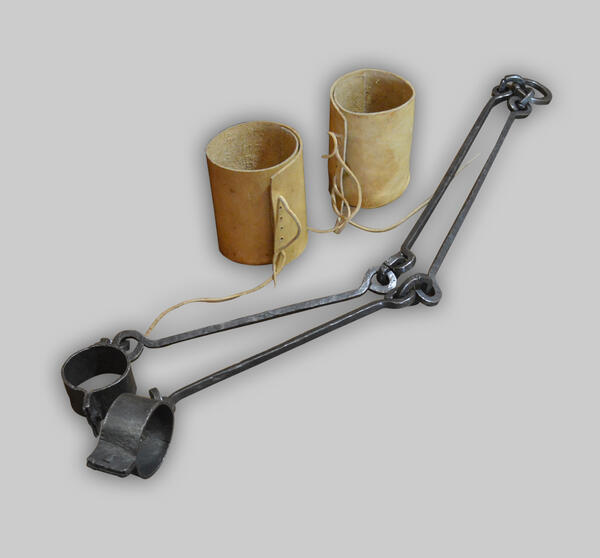Shackles specifically adapted for work consisted of four-finger-thick iron rods. They were attached to a waist belt with a middle connecting ring and worn under the outerwear. They weighed about four or five kilos. Convicts wore them all the time: at work, in the bathhouse, and during sleep. A convict was uncuffed only if he died or when his imprisonment ended. Dostoevsky wore these for four years in prison.
Here is what he wrote in the ‘House of the Dead’, ‘The chains, it is true, were not exceedingly heavy; they did not in general weigh more than eight or ten pounds, which is a supportable burden for a man in good health. I have been told, however, that after some years the legs of the convicts dry up and waste away. I do not know whether it is true. I am inclined to think it is; the weight, however light it may be (say not more than ten pounds), if it is fixed to the leg for ever, increases the general weight in an abnormal manner, and at the end of a certain time must have a disastrous effect on its development. For a convict in good health this is nothing, but the same cannot be said of one who is sick. For the convicts who were seriously ill, for the consumptive ones whose arms and legs dry up of themselves, this last straw is insupportable. Even if the medical authorities claimed alleviation for the consumptive patients alone, it would be an immense benefit, I assure you. I shall be told convicts are malefactors, unworthy of compassion; but ought increased severity to be shown towards him on whom the finger of God already weighs? No one will believe that the object of this aggravation is to reform the criminal. The consumptive prisoners are exempted from corporal punishment by the tribunal. There must be some mysterious, important reason for all this, but what it is, it is impossible to understand. No one believes—it is impossible to believe—that a consumptive man will run away. Who can think of such a thing, especially if the illness has reached a certain degree of intensity? It is impossible to deceive the doctors and make them mistake a convict in good health for one who is in a consumption, for this malady is one that can be recognised at the first glance. Moreover, can the irons prevent the convict not in good health from escaping? Not in the least. The irons are a degradation and shame, a physical and moral burden; but they would not hinder any one attempting to escape. The most awkward and least intelligent convict can saw through them, or break the rivets by hammering at them with a stone. Chains, then, are a useless precaution; and if the convicts wear them as a punishment, should not this punishment be spared to dying men? ’.
Here is what he wrote in the ‘House of the Dead’, ‘The chains, it is true, were not exceedingly heavy; they did not in general weigh more than eight or ten pounds, which is a supportable burden for a man in good health. I have been told, however, that after some years the legs of the convicts dry up and waste away. I do not know whether it is true. I am inclined to think it is; the weight, however light it may be (say not more than ten pounds), if it is fixed to the leg for ever, increases the general weight in an abnormal manner, and at the end of a certain time must have a disastrous effect on its development. For a convict in good health this is nothing, but the same cannot be said of one who is sick. For the convicts who were seriously ill, for the consumptive ones whose arms and legs dry up of themselves, this last straw is insupportable. Even if the medical authorities claimed alleviation for the consumptive patients alone, it would be an immense benefit, I assure you. I shall be told convicts are malefactors, unworthy of compassion; but ought increased severity to be shown towards him on whom the finger of God already weighs? No one will believe that the object of this aggravation is to reform the criminal. The consumptive prisoners are exempted from corporal punishment by the tribunal. There must be some mysterious, important reason for all this, but what it is, it is impossible to understand. No one believes—it is impossible to believe—that a consumptive man will run away. Who can think of such a thing, especially if the illness has reached a certain degree of intensity? It is impossible to deceive the doctors and make them mistake a convict in good health for one who is in a consumption, for this malady is one that can be recognised at the first glance. Moreover, can the irons prevent the convict not in good health from escaping? Not in the least. The irons are a degradation and shame, a physical and moral burden; but they would not hinder any one attempting to escape. The most awkward and least intelligent convict can saw through them, or break the rivets by hammering at them with a stone. Chains, then, are a useless precaution; and if the convicts wear them as a punishment, should not this punishment be spared to dying men? ’.



